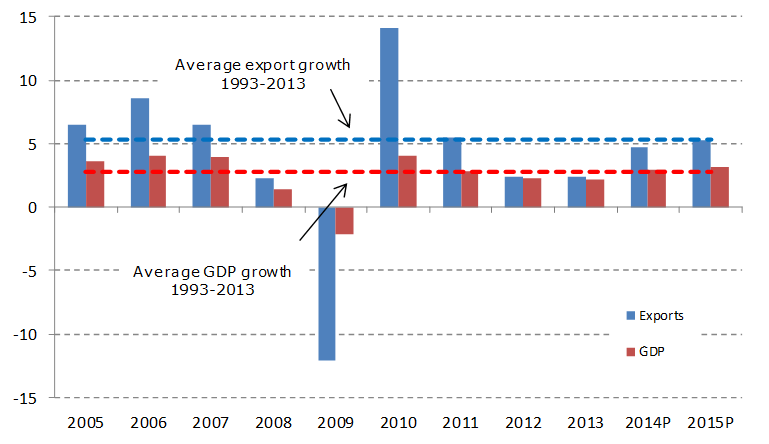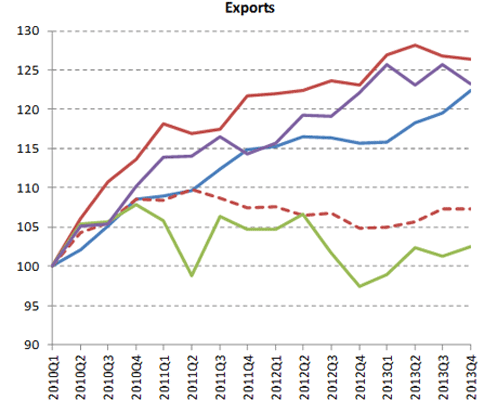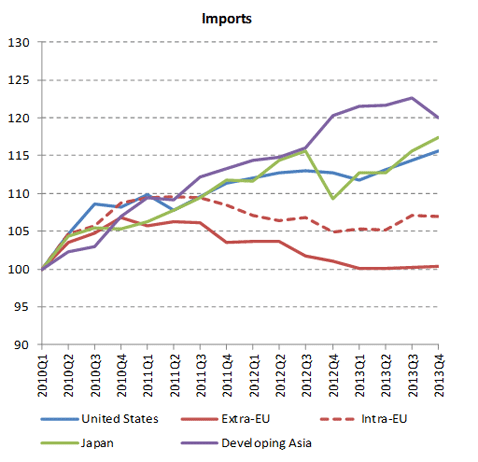Introduction
The World Trade Organization (WTO) is an international organization, which was established on January 1, 1995 as a predecessor to the GATT. The organization’s goal is to ensure optimal supervision and liberalization of international trade by regulating trade between member states. Furthermore, the WTO has formulated a framework, which guides the dispute resolution process and formalization of trade agreements. Subsequently, the definition of the WTO is multifaceted.
First, the organization can be defined as an organization that enhances trade opening, providing organizations with an opportunity to negotiate trade agreements, and to deal with diverse trade disputes. The organization has experienced significant growth over the past two decades. Currently, the WTO has a membership of 159 countries. This paper evaluates the good and the bad about the WTO.
Background information
The operations of the WTO are determined by the various member states. However, the various activities are coordinated by a secretariat, which is comprised of 600 employees who are experts in different areas such as economics, law, communication, and statistics. The secretariat is charged with the responsibility of overseeing the organization’s day-to-day operations such as ensuring that negotiations are conducted smoothly and the various WTO rules and regulations are correctly applied.
The WTO engages in numerous trade agreements in an effort to improve its operational efficiency. The organization’s agreements take into account diverse products such as goods, services, and intellectual property. Moreover, the organization’s agreements outline the member states’ commitment to eliminate trade barriers for example lowering customs tariffs.
The open policy has led to a remarkable improvement in international trade between the various member states. The trade agreements are continually reviewed in order to improve their effectiveness. Currently, the WTO’s trade negotiations are being reviewed through the Doha Development Agenda, which was launched in 2001 in Doha, Qatar (World Trade Organization par.3).
The WTO requires the various member states to formulate their respective trade policies. However, the member states must notify the WTO on the policies adopted and the level of transparency. Subsequently, the WTO safeguards its members against arbitrary changes on the trade policies such as custom duties.
This move has played an essential role in ensuring fairness and predictability with regard to trade between member states. Moreover, the organization undertakes periodic evaluation of the member states’ trade policies and regulations through the secretariat.
The WTO has formulated comprehensive dispute resolution procedures, which are outlined in the Dispute Settlement Understanding. The procedures are critical in ensuring smooth trade between member states. Subsequently, member states can escalate their trade issues to the WTO’s secretariat if they feel that their trade agreements are being infringed. The dispute resolution process is undertaken under the watch of experts who interpret the trade agreements of the respective member states.
In an effort to increase its membership, the organization provides developing countries an opportunity to implement their trade agreements over a longer duration. The privileges given to member states have played a remarkable role in attracting developing countries to join the WTO. It is estimated that over 75% of the WTO’s member states are developing countries (World Trade Organization par.5).
Furthermore, the organization ensures that there is no discrimination in the process of conducting trade between member states. This aspect has played a critical role in building the WTO’s trade capacity. Moreover, the WTO undertakes numerous conventions in an effort to educate its members on the importance of adhering to the trade agreements.
Furthermore, the organization has established a strong working relationship with non-governmental organizations, the media, and international organizations in its quest to foster cooperation and create awareness on its operations.
Good trade policies adopted by the WTO
The WTO is focused towards creating a free environment for conducting trade amongst the member states. In order to achieve this goal, the WTO has instituted comprehensive protectionist measures. The WTO has incorporated a comprehensive global trade system, which has led to a significant reduction in trade barriers amongst member states.
Furthermore, the trade policies between member states are formulated through a comprehensive negotiation process. The protectionism implemented by the WTO trade policies has led to significant the improvement in the citizens’ living standards. Moreover, trade between the various member states has led to a significant reduction in the citizens’ cost of living.
Free trade amongst the various member states has presented consumers with more choice of goods and services. Moreover, consumers are in a position to access high quality products, which enhance their utility level.
By adopting free trade between member states, the WTO has been in a position to stimulate economic growth amongst member states. One of the sources of economic growth relates to the creation of employment opportunities. For example, the member states increase their trading partners, which lead to increment in the size of their international market.
This aspect means that respective countries can export their products and services to member states cost effectively. Increase in the volume of trade between member states stimulates growth of different economic sectors in the member states.
Free trade policy has greatly improved economic growth of the WTO’s member states by promoting technological advancement. The policy presents member states with an opportunity to share knowledge and expertise on technology, which is a critical pillar in promoting a country’s economic growth.
The free trade policy adopted by the WTO has led to significant improvement in peace amongst member states. For example, the WTO’s trading system has implemented a comprehensive dispute resolution mechanism. Moreover, member states are required to ensure that trade with other member states flows smoothly, which has led to a significant improvement in the level of cooperation amongst countries.
Criticism of trade policies
One of the main core aspects in the WTO’s operation entails the elimination of trade barriers. The WTO encourages member states to eliminate various obstacles that might hinder trade amongst member states. Currently, organizations are increasingly using the WTO as an avenue to eliminate the diverse environmental protection mechanisms, which have been instituted.
For example, the WTO ruled the US Clean Air Act, which required both domestic and international companies operating in the US to adopt clean sources of energy, as illegal. Moreover, the WTO “illegalized the US Endangered Species Act, which was formulated in an effort to protect the endangered sea turtles from anglers and this aspect illustrates the extent to which the WTO is committed towards deregulation of various industries such as fishing, energy, logging, and energy distribution” (Strange 92).
The free trade policy adopted by the WTO has led to an increment in the level of inequality amongst member states. The period ranging between “1960 and 1998 was characterized by rapid growth in international investment and trade” (Strange 96); however, this period was characterized by extensive inequality.
A report released by the United Nations Development Program (UNDP) in 2013 shows that 20% of the world’s population consume 80% of the world’s total resources (Strange 101). On the other hand, 80% of the poorest population consumes only 14% of the total world resources (Strange 101). The establishment of the WTO has fostered inequality by giving member states an opportunity to undertake foreign direct investment in the less developed countries where labor is cheap.
Equal decision-making power policy- the WTO has an obligation to ensure that all the member states participate in the process of formulating trade policies. However, the organization favors the rich and developed countries in the policy formulation process. The less developed countries are not given equal decision-making power. In most cases, the less developed countries are not invited to ‘closed door’ meetings where crucial trade agreements are formulated.
Subsequently, the less developed countries are greatly disadvantaged due to the lack of representation in the process of formulating trade agreements. Moreover, the WTO asserts that its decision-making process is through consensus. However, achieving consensus of over 159 countries is challenging, which further limits the effectiveness of the organization.
During its establishment, the WTO had the objective of implementing protectionist economic policies. Subsequently, the organization was required to foster a high level of coherence in the economic policy-making process. However, the organization has not been in a position to curb the high rate at which the developed countries such as the G20 formulate trade policies in an effort to respond to macroeconomic changes such as the recent global economic recession. The G20 countries have continued to adopt protectionist measures.
The WTO is discriminative in its application of trade policies. For example, the less developed countries in Africa are required to eliminate 90% of their trade barriers in order to ascend to the WTO. The application of this policy is necessitated by the fact that the organization has not formulated clear policies to protect the less developed countries
Despite the economic benefits associated with free trade between member states, WTO has not take into account human rights. Bigelow and Peterson (2009) argue that the “WTO has refused to address the impact of free trade on labor rights, despite the fact that countries that actively enforce labor rights are disadvantaged by competition from countries that consistently violate international labor conventions” (p.105). This assertion shows the ineffectiveness of the WTO’s competition policy.
Most developing countries consider cheap labor as a source of competitive advantage. However, the WTO has instituted labor standards, which consider cheap labor as a barrier to free trade, hence diminishing the competitive of the less developed countries. Moreover, the organization has adopted ineffective labor policies.
The WTO contends that it is illegal for the member states to prohibit trade amongst member states on product-based issues. For example, “a country should not ban international trade on the basis that a product is produced through child labor” (Strange 119). Furthermore, the organization has not implemented a policy outlining how to deal with companies from member states that trade with vicious dictators.
The WTO has instituted a comprehensive policy, which protects intellectual property rights such as patents and copyrights. However, such protection is at the expense of the society. For example, the organization may protect companies engaging in production of pharmaceutical products, which might endanger peoples’ health.
The less developed countries such as the Sub-Saharan countries may be adversely affected by such policies. For example, the Sub-Saharan countries may import cheaper, but substandard drugs from the various member states in an effort to deal with diseases such as HIV/AIDS.
The Doha Round
The WTO defines the Doha Round or the Doha Development Agenda as the latest trade negotiations between the various WTO members. The aim of the Doha Round is to reform the prevailing WTO trade policies. Furthermore, the organization intends to minimize trade barriers amongst member states. For example, the Doha Round intends to minimize trade policies by cutting import taxes.
The WTO considers import taxes as a major hindrance in fostering trade amongst trade partners. This aspect arises from the view that import taxes are applicable to all commodities, which limit the effectiveness with which countries undertake international trade.
The Doha Round has focused on different economic sectors such as agriculture and the service sector such as the banking industry. The talks aim at creating more market for agricultural products via the termination of export grants and high tariffs. Moreover, the Doha Round is also committed to improving its operational efficiency by reviewing its current intellectual property rights.
The round is also concerned with reviewing how and to what extent member states can promote foreign investment. All the member states are required to participate in the Doha Round talks. However, the talks are dominated by the developed economies such as the European Union countries, India, and China.
The Doha Round talks are based on the concept of a single undertaking, which means that all the parties must agree with a particular idea before it can be adopted as a policy. Subsequently, failure to come into consensus leads to failure of the entire talks. The previous rounds, which have been conducted, have lasted for over 70 years, which highlights the sluggish nature of the talks. Subsequently, it is difficult to assert whether Doha round will ever end.
Free trade policy is focused on promoting international trade through import and export trade. Therefore, it is imperative for a country to specialize in the production of specific products. The operation of WTO can be explained by different free trade theories. Some of these theories include the absolute theory and the comparative advantage theory. Absolute advantage theory contends that some countries have the capability of producing certain products and services at a relatively low absolute cost as compared to other countries.
For example, Asian countries such as China have the capability of producing certain goods and services more cost-effectively due to the availability of cheap labor. Furthermore, the Middle East countries have the capability of producing crude oil due to their huge petroleum reserves.
On the other hand, comparative advantage refers to the ability of a country to produce a certain product at a lower cost as compared to other countries. For example, the United States has the capability to produce computer chips more cost efficiently. Similarly, Sweden can produce steel products such as axes cost effectively.
Despite these aspects, the two countries have the ability to produce the two products. However, it is important for a country to specialize on what it produce can cost efficiently. Specialization enables the WTO’s member states to interact through the importation and exportation of products and services.
Data and theory analysis
The establishment of the WTO’s trading system has played a remarkable role in improving international trade amongst countries. A report released by the WTO shows that the global trade would grow with a margin of 4.7% in 2014, which is twice the rate of growth experienced in 2013 (Strange 142).
Furthermore, the WTO has projected a 5.3% growth in 2015 (Strange 143). The sluggish growth rate in 2013 emanated from a decline in the volume of imports amongst the developed economies, which grew with a 0.2% margin. On the other hand, the volume of imports in the developing economies grew remarkably with a margin of 4.4%.
The WTO’s trading system has also led to a significant improvement in the volume of exports in both the developing and the developed economies. The volume of export in the developing economies increased by 3.3% while that of the developed economies increased by 1.5%, which illustrates the significance of the WTO in promoting international trade.
The WTO projects growth in the volume of world trade in the future. The growth is expected to emanate from the improvement in world economies. For example, most economies are on a recovery path from the adverse effects of the 2008 global financial crisis. The chart below illustrates the trend with regard to average GDP and growth in the volume of exports.

The formation of the WTO has given way to a substantial improvement in the volume of international trade amongst member states over the past decade. The figures below illustrate the trend with regard to export and import trade amongst Japan, United States, Asia, Extra-EU, and Intra-EU trade.


The graphs above show that the establishment of WTO has led to significant improvement in the volume of imports and exports amongst member states. From the trend above, one can argue that the WTO will play a significant role in fostering international trade in the future.
Conclusion
This research paper identifies the WTO as an important component in countries’ efforts to achieve economic growth. The organization was established with the objective of fostering trade amongst member states. In addition, the organization has undergone significant growth over the past as evidenced by the growth in its membership.
In a bid to achieve its objective, the WTO has instituted a comprehensive framework of policies, which aim at promoting international trade. Some of the issues that the WTO has integrated into its policies include non-discrimination of trading partners, a high level of transparency, environmental protection, and fair competition. The adoption of free trade policy has enhanced economic growth amongst the developing and the developed economies.
For example, the free trade policy requires member states to eliminate trade barriers. Some of these trade barriers include taxes and tariffs. Additionally, the establishment of the WTO has stimulated economic growth through creation of employment opportunities. For example, the member states increase their trading partners, which lead to increment in the size of their international market.
Despite its success in fostering economic growth amongst member states, the WTO policies have been criticized for promoting inequality amongst member states. Furthermore, the WTO does not adhere to equal decision-making policy. The developed countries have more power in the decision making process as compared to their developing counterparts.
Furthermore, the WTO’s policies have been criticized for promoting abuse of human rights for example child labor. Despite the limitation, the WTO is committed to improving its operations by reviewing its trade policies continuously, which is currently being conducted through the Doha Round.
Works Cited
Bigelow, B., and Peterson, B. Rethinking globalization; teaching for justice in an unjust world, New York: Rethinking Schools, 2009. Print.
Strange, M. Writing Global Trade Governance: Discourse and the WTO (Interventions), New York: Routledge, 2013. Print.
World Trade Organization: Understanding the WTO; what we stand for 2013. Web.
